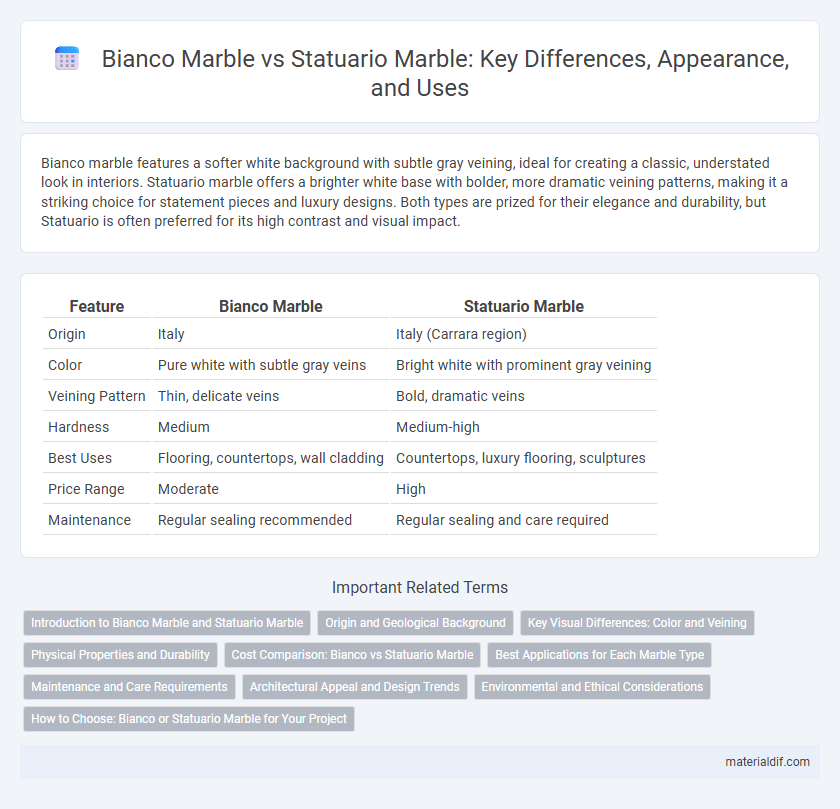Bianco marble features a softer white background with subtle gray veining, ideal for creating a classic, understated look in interiors. Statuario marble offers a brighter white base with bolder, more dramatic veining patterns, making it a striking choice for statement pieces and luxury designs. Both types are prized for their elegance and durability, but Statuario is often preferred for its high contrast and visual impact.
Table of Comparison
| Feature | Bianco Marble | Statuario Marble |
|---|---|---|
| Origin | Italy | Italy (Carrara region) |
| Color | Pure white with subtle gray veins | Bright white with prominent gray veining |
| Veining Pattern | Thin, delicate veins | Bold, dramatic veins |
| Hardness | Medium | Medium-high |
| Best Uses | Flooring, countertops, wall cladding | Countertops, luxury flooring, sculptures |
| Price Range | Moderate | High |
| Maintenance | Regular sealing recommended | Regular sealing and care required |
Introduction to Bianco Marble and Statuario Marble
Bianco Marble features a white or off-white base with subtle grey veining, renowned for its elegance and versatility in interior design. Statuario Marble stands out with its bright white background contrasted by dramatic, bold grey veining, often favored for luxurious and high-end applications. Both types of marble originate from Italy's Carrara region, celebrated for their distinct aesthetic qualities and premium durability.
Origin and Geological Background
Bianco marble originates primarily from Carrara, Italy, characterized by its consistent white base and subtle grey veining formed during the Jurassic period in a marine sedimentary environment. Statuario marble, also sourced from Carrara quarries, exhibits a more pronounced white background with bold, distinctive veining resulting from metamorphic processes that altered limestone under high pressure and temperature. Both marbles are prized for their purity and strength, reflecting unique geological histories that influence their distinct aesthetics and applications in luxury architecture and sculpture.
Key Visual Differences: Color and Veining
Bianco marble features a soft white base with subtle, light gray veining that creates an understated and uniform appearance. Statuario marble stands out with a bright white background enhanced by bold, pronounced gray veining that offers a striking and high-contrast visual impact. The intense veining patterns in Statuario marble make it ideal for statement pieces, while Bianco marble suits spaces requiring a more delicate and harmonious look.
Physical Properties and Durability
Bianco marble features a fine-grain texture with a creamy white base and subtle veining, offering moderate hardness and durability suitable for interior applications like countertops and flooring. Statuario marble exhibits a denser, crystalline structure with a bright white background and bold, dramatic veining, providing higher strength and enhanced resistance to scratching and etching. Both types are calcite-based but Statuario marble's superior compactness makes it more durable for high-traffic areas and exterior use.
Cost Comparison: Bianco vs Statuario Marble
Bianco marble generally costs less than Statuario marble due to its more abundant availability and less intricate veining patterns. Statuario marble commands a higher price because of its rarity, distinctive bold veining, and superior quality, making it a premium choice in luxury projects. The cost difference can be significant, with Statuario often priced 20-40% higher than Bianco marble, impacting budget decisions in construction and design.
Best Applications for Each Marble Type
Bianco marble, prized for its consistent white background with subtle gray veining, is ideal for flooring and wall cladding in modern and minimalist interiors where a clean, uniform look enhances spaciousness. Statuario marble, characterized by its dramatic, bold veining patterns and bright white base, excels in statement applications such as countertops, feature walls, and high-end bathroom vanities where visual impact is paramount. Both marbles perform well in residential and commercial projects but are selected based on the desired aesthetic effect and space functionality.
Maintenance and Care Requirements
Bianco marble requires regular sealing to prevent staining and should be cleaned with pH-neutral products to maintain its polished surface. Statuario marble demands more frequent sealing due to its higher porosity and is susceptible to etching, so avoiding acidic cleaners is crucial. Both types benefit from prompt spill cleanup and protective measures like coasters and mats to preserve their natural beauty.
Architectural Appeal and Design Trends
Bianco marble showcases a consistent white base with soft gray veining, making it a favored choice for minimalist and contemporary architectural designs. Statuario marble, prized for its bright white backdrop and dramatic, bold veining, is often featured in luxury interiors and high-end design projects for an opulent aesthetic. Current design trends highlight Statuario marble in statement pieces like countertops and feature walls, while Bianco marble is predominantly used for sleek flooring and subtle wall accents.
Environmental and Ethical Considerations
Bianco marble typically has a lower environmental impact due to more localized quarrying and less intensive processing compared to Statuario marble, which is often sourced from distant Italian quarries requiring extensive transportation. Ethical considerations highlight that Bianco marble quarries tend to implement more sustainable mining practices and ensure better labor conditions, whereas Statuario marble extraction has faced scrutiny over environmental degradation and worker safety. Choosing Bianco marble supports more eco-friendly sourcing and aligns with responsible material procurement standards.
How to Choose: Bianco or Statuario Marble for Your Project
Choosing between Bianco and Statuario marble depends on the project's aesthetic and durability requirements; Bianco marble offers a consistent white background with subtle gray veining, ideal for minimalist designs, while Statuario marble features bold, dramatic veining patterns suited for statement pieces. Consider the location and usage, as Statuario marble's higher density makes it more resistant to staining and wear, perfect for high-traffic areas like kitchens and bathrooms. Budget also plays a role; Statuario tends to be more expensive due to its rarity and distinctive veining, whereas Bianco provides a cost-effective alternative without compromising elegance.
Bianco Marble vs Statuario Marble Infographic

 materialdif.com
materialdif.com